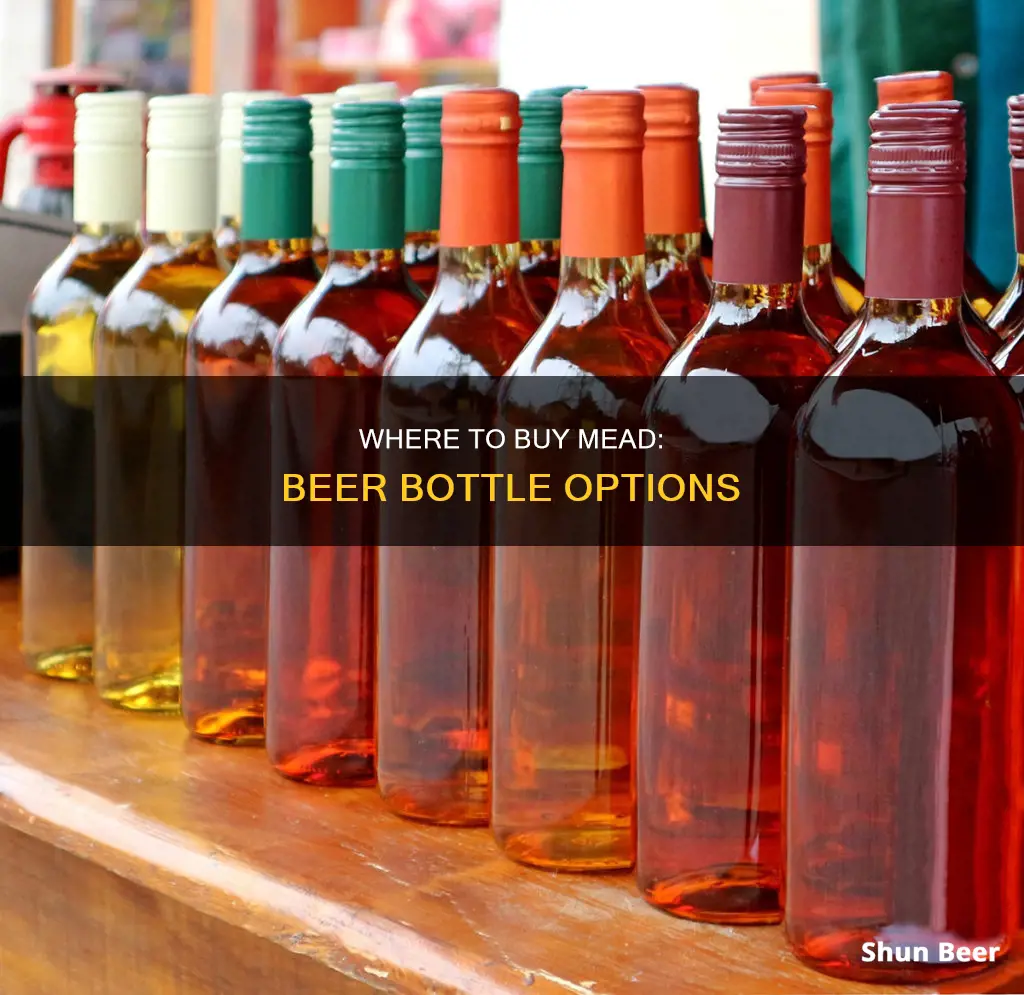
Homebrewers of mead often wonder about the best way to bottle their product. Beer bottles are a popular choice for bottling mead, and many people have successfully bottled their mead in beer bottles with no issues. Beer bottles come in 12, 16, or 22 oz varieties and can be capped with a crown cap and a capper. This method is suitable for still or carbonated meads, and the smaller bottle size is convenient for those who don't want to drink an entire wine bottle in one sitting.
What You'll Learn

Beer bottles are a good option for bottling mead
Another advantage of using beer bottles for mead is the convenience of vertical storage. Beer bottles with crown caps allow for secure storage without the worry of bottle bombs, as the caps can handle the pressure. Additionally, if you're a regular beer drinker, you can repurpose beer bottles from brands like Grolsch or Fischer, which have flip-top or swing-top closures. These bottles are resealable and reusable, eliminating the need for bottle caps or a capping tool.
When bottling mead, it's important to follow proper sanitation practices to prevent spoilage. All bottles, caps, corks, tubing, and related equipment must be thoroughly sanitised to ensure the mead's quality and longevity. It's also crucial to minimise contact with oxygen during the bottling process, as oxygen can negatively impact the flavour of your mead. Using siphons and proper bottling techniques will help reduce oxygen exposure.
Overall, beer bottles offer a practical and economical solution for bottling mead. They are easily accessible, provide a range of volume options, and ensure secure storage. By following the necessary sanitation and bottling procedures, you can effectively bottle your mead using beer bottles and enjoy your homemade creation.
Helium Beer Legality in Canada: Can You Buy It?
You may want to see also

Oxygen-absorbing caps are recommended for bottling mead
Oxygen-absorbing caps are highly recommended for bottling mead. They are designed with a special liner that absorbs oxygen in the bottle's headspace, reducing oxidation during the bottling process and extending the shelf life of your brew. This is particularly important for mead, as oxygen can negatively impact the flavour and freshness of your beverage.
The use of oxygen-absorbing caps can help to maintain the quality of your mead over time, ensuring that it remains tasting fresh and preventing it from becoming stale. This is especially beneficial if you plan on ageing your mead or storing it for extended periods. By absorbing the oxygen, these caps create an optimal environment for your mead to develop and mature without the risk of oxidation.
Additionally, oxygen-absorbing caps offer a cost-effective solution. They are typically inexpensive and can be purchased in bulk, making them a convenient and affordable option for bottling your mead. They are also easy to use and do not require any special equipment or techniques beyond standard bottling practices.
When using oxygen-absorbing caps, it is important to note that they should not be sanitised before use. The oxygen-absorbing agent is activated when the cap comes into contact with moisture. Sanitising the caps before bottling may deplete the oxygen-absorbing properties, rendering them ineffective. Therefore, it is recommended to only sanitise the number of caps you intend to use at that time.
Overall, oxygen-absorbing caps provide an effective way to preserve the quality and freshness of your mead. By reducing oxidation, they help to maintain the intended flavour and extend the shelf life, making them an excellent choice for bottling your homemade mead.
Maryland's Best Beer: Where to Buy It
You may want to see also

Beer bottles are cheaper than wine bottles
Beer bottles are a common choice for bottling mead, and they are often cheaper than wine bottles. Beer bottles are typically made of glass or aluminium and come in different sizes, such as 12, 16, or 22 ounces. They are suitable for both still and carbonated meads. One of the main advantages of using beer bottles is their affordability. For example, a half-liter beer bottle from a supermarket might cost €0.50, and it comes with free beer inside! After consuming the beer, the bottles can be washed, and the labels removed, providing a cost-effective solution for bottling mead.
Another factor contributing to the lower cost of beer bottles is the type of closure they use. Beer bottles typically use crown caps or bottle caps, which are less expensive than corks used in wine bottles. Crown caps are widely available and suitable for both still and carbonated meads. The caps hold well, especially if the mead is not under pressure due to carbonation. Additionally, bottle caps allow for vertical storage, saving space compared to the horizontal storage required for corked bottles.
When it comes to bottling mead, some mead makers prefer to use wine bottles, especially for long-term aging. Wine bottles create a different aesthetic and can be beneficial for the flavour of the mead due to micro-oxygenation. However, wine bottles are generally more expensive than beer bottles and are not designed to hold pressure. If you plan to bottle a carbonated mead, wine bottles may not be the best choice as they can break under pressure.
In conclusion, beer bottles offer a more economical option for bottling mead compared to wine bottles. They are readily available, cost-effective, and suitable for both still and carbonated meads. For those seeking a more premium look or planning to age their mead for an extended period, wine bottles could be considered, but they come at a higher price point and have limitations regarding carbonation. Ultimately, the choice between beer bottles and wine bottles depends on personal preference, intended use, and budget constraints.
Newcastle Beer: Available in Salt Lake City, Utah?
You may want to see also

Beer bottles are ideal for those who don't drink a full bottle of wine in one sitting
Mead, a fermented honey beverage, can be bottled in a variety of containers, including beer bottles. Beer bottles are a convenient option for mead makers, especially those who also brew beer, as the required equipment, such as crown caps and cappers, is already available. The standard beer bottle sizes of 12, 16, or 22 ounces are ideal for serving sizes and can be used for both still and carbonated meads.
Beer bottles offer several advantages for those who don't consume a full bottle of wine in one sitting. Firstly, they provide a more suitable serving size. A standard beer bottle typically holds 350-500ml, which is significantly smaller than a standard 750ml wine bottle. This smaller volume aligns better with moderate drinking habits and helps prevent overconsumption.
Secondly, beer bottles are designed for convenience and portability. Their size and shape make them easy to grip and comfortable to hold, even when wet. This design feature ensures that the bottle doesn't slip out of your hand, making it ideal for those who enjoy their beverage directly from the bottle.
Additionally, beer bottles are often preferred due to their sealing mechanisms. Screw-top seals are widely used and offer convenience in sealing the bottle. On the other hand, swing-top seals provide a fun and stylish alternative, adding a touch of richness and history to the drinking experience.
Furthermore, beer bottles are more cost-effective and environmentally friendly. They are typically cheaper than wine bottles and corks, making them a budget-friendly option, especially for those who are not made of money. Additionally, beer bottles can be reused multiple times before requiring recycling, reducing waste and providing a more sustainable option.
In conclusion, beer bottles are indeed ideal for those who don't finish a full bottle of wine in one sitting. They offer appropriate serving sizes, convenient designs, cost-effectiveness, and environmental benefits. So, whether you're a homebrewer or a commercial producer, consider the advantages of bottling your beverage in beer bottles to cater to a wider range of consumers.
Exploring Light Beer Availability in Japan
You may want to see also

Wine bottles are better for long-term ageing
While beer bottles are a valid option for bottling mead, wine bottles are better for long-term ageing.
Additionally, wine bottles come in a variety of sizes and types, making them suitable for bottling still mead. They are also ideal for long-term ageing as they are designed to be stored on their side, which is the optimal position for ageing wine. Beer bottles, on the other hand, are better suited for carbonated meads as they can hold pressure, and their smaller size makes them a good option for serving sizes.
The choice between wine and beer bottles ultimately depends on the type of mead being bottled and the desired ageing process. However, if long-term ageing is the goal, then wine bottles are the superior option due to their ability to facilitate controlled oxygen exposure and their compatibility with still meads.
Exploring Beer Options at the Grand Canyon
You may want to see also
Frequently asked questions
Yes, you can use beer bottles to store mead. Beer bottles are a common choice for bottling mead due to their convenience and affordability. They are typically capped with crown caps or flip-top caps, which are easy to seal and store.
Beer bottles offer several advantages for mead bottling:
- They are readily available and affordable, especially if you drink beer regularly and can repurpose the bottles.
- The smaller size of beer bottles, typically 12 oz or 16 oz, is more suitable for serving sizes and allows for easier storage and handling.
- Capped beer bottles are ideal for carbonated meads as they can handle the pressure better than corked wine bottles.
- Crown caps or flip-top caps are easier to use than corks and reduce the risk of "bottle bombs" caused by ongoing fermentation.
There are a few potential downsides to consider when using beer bottles for mead:
- Beer bottles have larger headspace compared to wine bottles, which may impact the aging process and flavour development. However, this can be mitigated by using oxygen-absorbing caps or wax seals.
- The smaller size of beer bottles means you will need more bottles to store the same amount of mead, which can be less convenient for larger batches.
- Some people prefer the traditional look of corked wine bottles, especially for long-term aging and gift-giving.
Bottling mead in beer bottles is a straightforward process:
- Sanitize all bottles, caps, tubing, and equipment that will come into contact with the mead.
- Rack the mead about a week before bottling to remove yeast lees and ensure fermentation is complete.
- Transfer the mead into a sanitized fermentation bucket with priming sugar if you are making a sparkling mead.
- Siphon the mead into the beer bottles, leaving enough headspace for the cap.
- Seal each bottle with a crown cap or a flip-top cap.
- Store the bottled mead in a cool, dark location for aging, typically for at least two to three weeks or up to a year.
Mead stored in beer bottles with proper sanitation and sealing can last for many years. The higher alcohol content of mead and the use of sulfites help preserve the beverage. With proper bottling and storage, you can expect mead to remain drinkable for at least 2 to 3 years, and often much longer.







